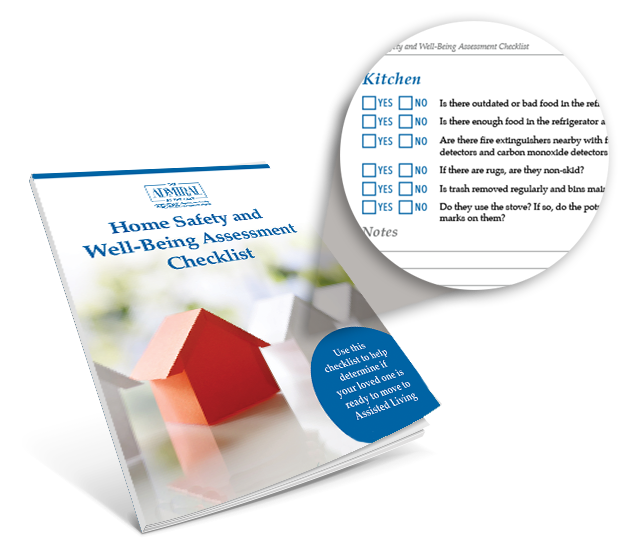August 17, 2021
.jpg) As your parent or loved one grows older, you may ask yourself if it’s the right time for them to move to a retirement community. While there’s no clear-cut answer in many situations, assessing the state of their home and overall well-being can help you make the decision.
As your parent or loved one grows older, you may ask yourself if it’s the right time for them to move to a retirement community. While there’s no clear-cut answer in many situations, assessing the state of their home and overall well-being can help you make the decision.
Let’s take a closer look at home assessments and how they can help you determine if it’s time to consider moving your parent to a retirement community like The Admiral at the Lake.
What is a Home Assessment for Seniors?
A home assessment for older adults in the process of evaluating each room in their home, along with the home’s overall state of cleanliness and safety. Such an assessment can help you see if your loved one is struggling to meet the activities of daily living (ADLs), or if their living arrangements are no longer easy or safe for them to be in.
A home assessment doesn’t have to give you a verdict on whether or not your loved one can continue living at home. Instead, it might help you pinpoint ways you can make their home a bit safer and keep them living independently longer.
You can do a preliminary home assessment yourself, or you can work with a professional from a local hospital, clinic or care center. An assessment might take more than one day as you note observations, so be prepared to spend some time doing it.
Three reasons you should talk to your parent about moving to a Lifecare community >>
How to Conduct a Home Safety Assessment for Seniors
The goal of a home assessment is to explore your loved one’s home and make sure they can still live there independently and safely. The evaluation can also help you see their mental and emotional well-being.
If you’re conducting the assessment yourself, here are some key pieces to look for. This isn’t a comprehensive list, but it can help you get started:
- Your loved one’s ability to take care of the activities of daily living (feeding themselves, using the bathroom, bathing, getting dressed).
- Are they maintaining the right weight?
- Do they look clean and well-groomed?
- Are they dressed appropriately in clean clothes?
- The overall safety and repair of their home.
- Are there stairs? Can they navigate them?
- Is the lighting adequate?
- Are the rooms clean as they normally would be?
- The way your loved one handles chores.
- Are they taking their medication properly?
- If they drive, do they get themselves to appointments on time? If they don’t drive, do they make arrangements?
- Are the bills being paid on time?
- Their social network and support system.
- Do they talk to friends, family or neighbors regularly?
- Can they easily contact these people if needed?
- Do they take part in social groups, religious activities or community associations?
If you find yourself answering ‘no’ to many of these questions, it could be a sign that your loved one would benefit from living at a continuing care retirement community.
And if you answer ‘no’ to just a few questions and still feel confident in your loved one’s ability to live independently, you might think of solutions that would help. For example, if they need help with housework, you could consider hiring a cleaning service.
Just remember – at a certain point, making home renovations and hiring help can become more costly and less effective than a move to a continuing care retirement community. Carefully weigh all your options and consider the pros and cons of each choice before you make a decision.
Related: The hidden costs of aging in place >>
Get Your Free Home Assessment Checklist
 We’ve created a handy checklist to help you evaluate your loved one’s home and overall well-being. With this free resource, you’ll get:
We’ve created a handy checklist to help you evaluate your loved one’s home and overall well-being. With this free resource, you’ll get:
- Questions to ask yourself of each room in the home
- Ways to evaluate their physical and mental health
- More information about care options
Download your copy today and learn more about helping your loved one live their best life.